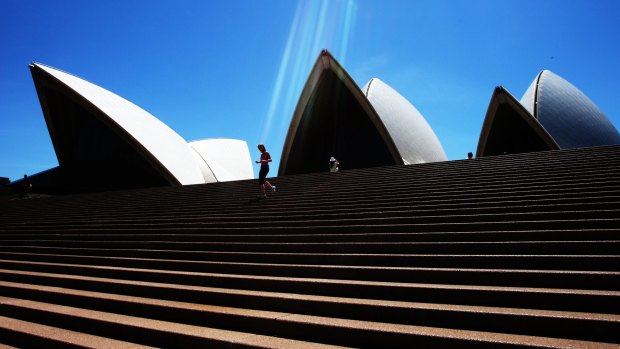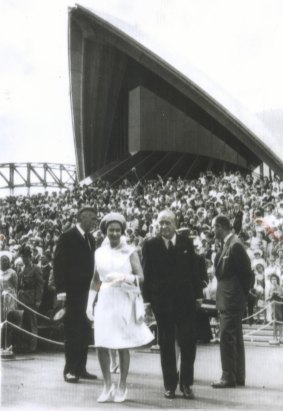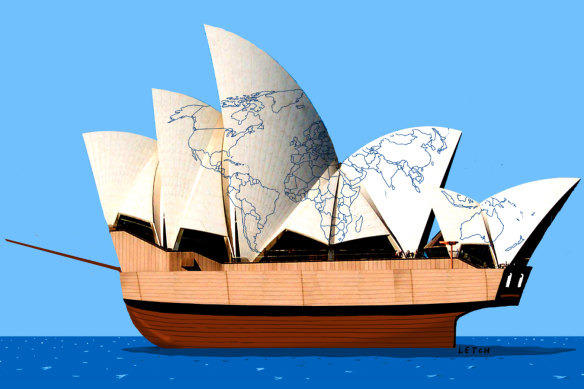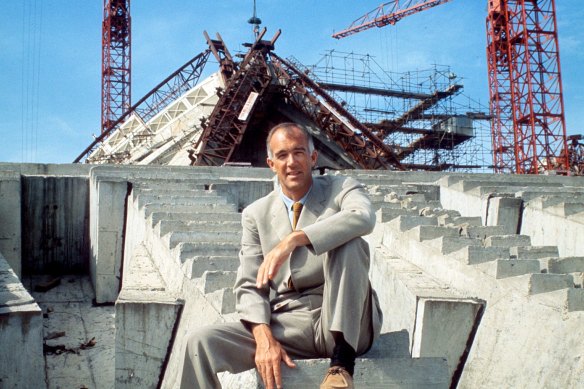This was published 1 year ago
Opinion
Jørn again: In the year of the Voice, our unfinished Opera House is a perfect national symbol
Nick Bryant
Journalist and authorLong before I had ever stepped foot in Australia, the Sydney Opera House exerted a magnetic pull. As a child, I dreamt of becoming an architect. Until the penny dropped that my creations were both aesthetically unappealing and structurally unsound, it was the subject I studied at university. Even after changing course, Jørn Utzon’s opus continued to be an object of fascination and delight. Surely it was the superlative building of the 20th century, more enchanting than Frank Lloyd Wright’s Falling Water, more pleasing on the eye than Le Corbusier’s brutalist masterpiece, the Notre-Dame du Haut.

Defying simple definition, the Opera House can still astound us from many angles. Credit: Peter Braig
One of the gifts of living in Sydney has been to study the building from so many angles. Not just the picture-postcard staples, but the lesserknown perspectives. Viewed from the Botanical Gardens, its shells look like the unhatched eggs of some giant Jurassic creature. From the highway on the north side of the harbour, it looks more like a cathedral, a Sagrada Familia of the south.
What I had failed to appreciate before coming to live here was how the Opera House was also a structure of such multiple meaning, and how it encapsulated the contradictions of the country it has come to symbolise. Just as you can physically project virtually anything onto its shells, you can vest the building with all manner of definitions. The country’s most instantly recognisable building is a landmark to Australian ambiguity.
The most obvious interpretation is that the project became a marker of Australia’s postwar ambition, and its desire to make an international statement. The search for the architect became a global undertaking. It was a Finnish-American architect, Eero Saarinen, who plucked Utzon’s design from the reject pile having eyed its visionary potential.

Queen Elizabeth opens the Sydney Opera House in 1973.
As the building started to take shape – even its skeleton was staggeringly beautiful – it became a monument of postwar multiculturalism. Many of the construction workers were new immigrants from southern Europe. When the Black American opera singer Paul Robeson performed an impromptu concert amid the scaffolding in 1960, his booming rendition of Ol’ Man River could almost have been a musical foreshadowing of the end of the White Australia policy.
This was a house built with lottery funding, proof of the centrality of gambling in Australian life. In the mid-50s, the conductor who pushed for its creation, Sir Eugene Goossens, was prosecuted for possessing indecent books, pictures and films, which spoke of the wowserism and censoriousness of the postwar years.
Then, of course, there was the enforced resignation of Jørn Utzon, when cost blowouts and construction delays threatened the entire project. This showed how parochialism could often smother internationalism. A foreign architect obsessed with form was replaced with a local architect, Peter Hall, preoccupied with function. This meant that Utzon’s planned interiors, which would have been as multi-coloured as its shells were monochromatic, never came to be realised. The inside of the Opera House, then, has always been anticlimactic, and a nagging reminder of the cultural cringe. Here, the foreign product was superior to the local.
The contradictions kept on coming. When Australia’s most celebrated building was opened in October 1973, it was a Briton, Elizabeth II, who performed the ribbon-cutting duties – ironically, she described the building as “a catalyst for Australia’s new and growing national spirit”. Only the day before, an amendment to the Royal Style and Titles Act made her “the Queen of Australia”, but it was indicative that the women of Australia did not feature more prominently.
The organisers of those opening festivities, however, made sure to acknowledge the original custodians of the land. Standing atop the apex of the highest shell, the Indigenous actor Ben Blakeney proclaimed: “I am Bennelong. And my spirit, and the spirit of my people, lives. And their dance, their music and their drama and their laughter also remains.”

Illustration: Simon Letch. Credit:
The inaugural program was a blend of high culture and the low, of the foreign and the local. In its new drama theatre, there were productions of plays by William Shakespeare and David Williamson. Sir Charles Mackerras conducted the prelude to Wagner’s Die Meistersinger von Nürnberg, while Rolf Harris performed Tie Me Kangaroo Down, Sport. The intention was clear: to counter the impression that the Opera House was only for “high brows”, and to promote a sense of cultural egalitarianism.
True to this “people’s house” ethos, its programming has always strived to be all-encompassing. It was beneath its shells that I heard for the first time the haunting voice of the late Geoffrey Gurrumul Yunupingu; that I saw its auditorium transformed into a giant indoor forest, an installation by the French artist Pierre Huyghe for the 2008 Sydney Biennale; that I saw the play Julia, climaxing in prime minister Gillard’s excoriating misogyny speech; and that I witnessed my eldest child experience his first live show, a production of The Gruffalo’s Child.
The building has become an instrument of Australian soft power and, in the most practical sense, an international stage for its diplomacy. This is where John Howard played host to George W. Bush at the 2007 APEC summit, and where Anthony Albanese was supposed to greet Joe Biden for this year’s cancelled Quad leaders’ summit. In more recent decades, its shells have been used to project international concern. They were illuminated in the colours of the French flag after the Paris terrorist attacks in November 2015 and the blue and yellow of Ukraine after Russian’s 2022 invasion.
Nowadays, it has also become a national billboard. Poppies on ANZAC Day. Photographs of battle-weary firefighters during the Black Summer blazes of 2020. From early on, it has also been a focal point of protest. Four years before the visit of George W. Bush, one of its shells was daubed with blood-red letters spelling out the words “No War” following his decision to invade Iraq. After Utzon’s constructive dismissal – oh, the irony of that term – placard-waving local architects rallied in his support.

Jørn Utzon in front of the partially constructed Opera House in 1965.Credit: Barry Peake/Shutterstock
In a country preoccupied with real estate, it’s also apposite that the Opera House occupies such a prime site. Deloitte’s reckons the building and land alone are worth $3 billion, or add on another $11.4 billion for its “social value”. Who knows what it would go for at auction?
For all that, the reason why the Opera House is such an ideal national symbol is because it is unfinished and incomplete. Though improvements have been made to dodgy acoustics, and peace made with Utzon’s descendants, it remains a work in progress. Most Australians, moreover, think it is great already and not in need of further improvement, which makes it doubly emblematic.
That its golden jubilee should coincide with the Voice referendum is therefore fittingly synchronous. As with the Opera House, so with the nation. Do you see an Australia already glorious and complete or a confounding country not yet fully realised?
Nick Bryant is the author of The Rise and Fall of Australia: How a Great Nation Lost its Way.